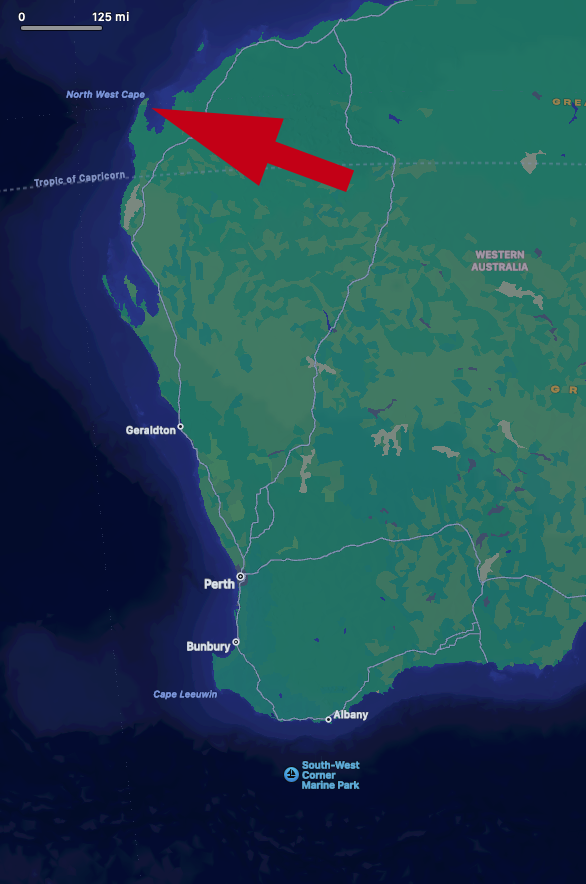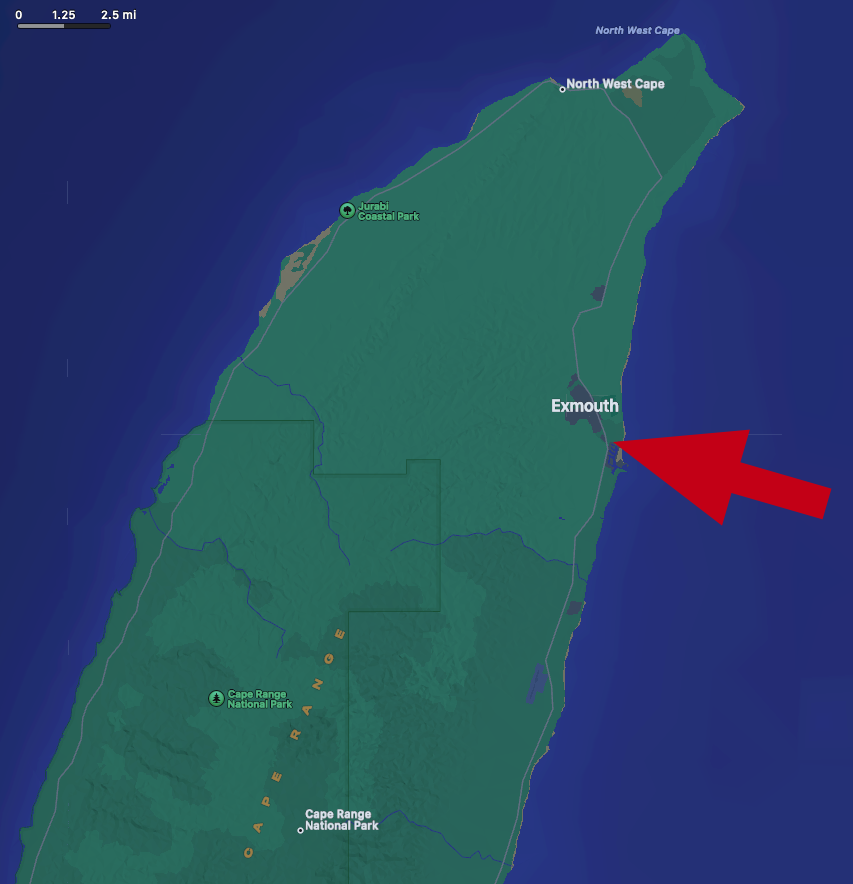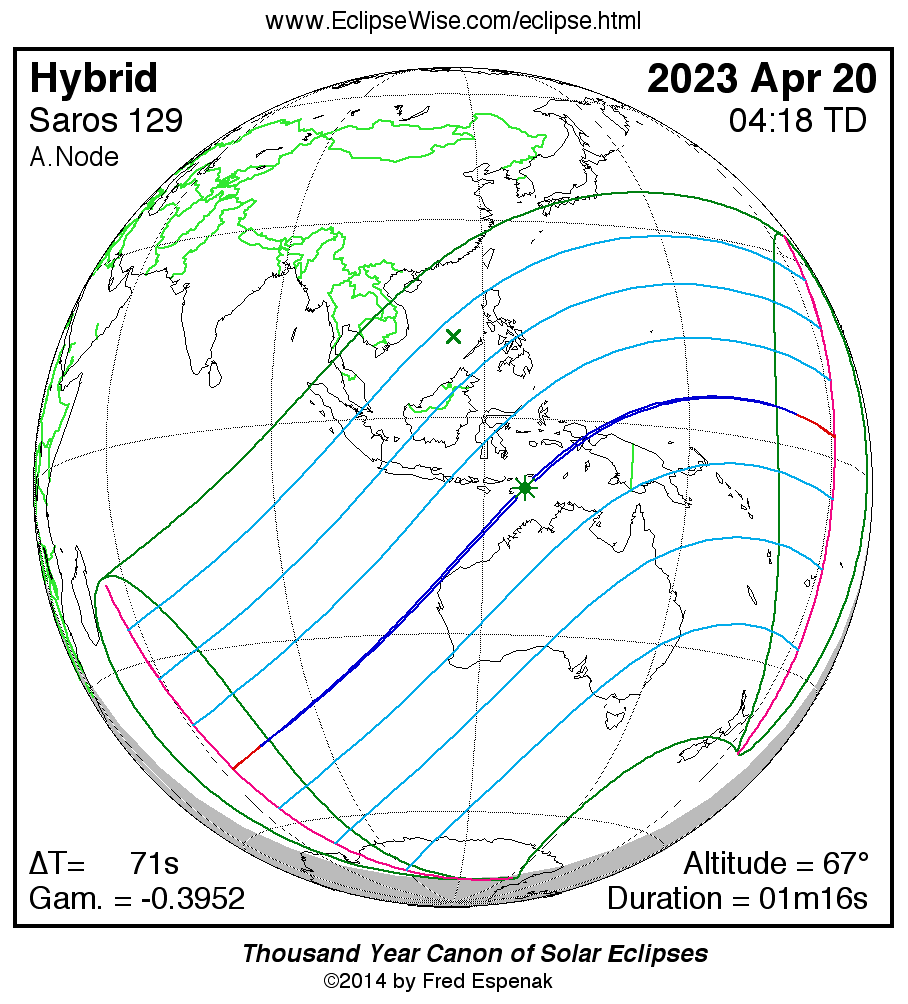2023 Total Solar Eclipse
For those not familiar with this formatting tool you can jump to the pretty pictures using the menu above. On a phone it will collapse into three lines at the top right of the screen. Click on any outlined image for a larger version. Click again for full size.
The Hybrid Solar Eclipse on August 20, 2023 (UTC) was mostly at sea. It did pass over one portion of extreme northwestern Australia. That is where the serious eclipse photographers converged. The pass near Exmouth, Western Australia lasted only about a minute. The site promised the best weather prospects in the eclipse path and a stable platform for photography.
I was fortunate to hook up with Astro Trails a British company. They located accommodations at the Exmouth Escape Resort. This was a nearly ideal location. It was a sort bus ride from town (the city provided a shuttle to manage traffic). There was an on site restaurant. Most importantly it was possible to set up right outside the rooms on a brick drive.
The one downside was that it required a charter flight to get to Exmouth. That caused some rather severe weight limitations. We were not quite at the "sawing toothbrush handles" stage as in a back packing trip, but my checked and carry on bags have never been weighed so many times. It meant leaving some "nice to have" equipment at home like my binoculars. That meant I mostly viewed the eclipse this time as shown in my iPhone video below.
Eclipse Movie
I usually try to capture a movie of the eclipse to show what the experience was like. In almost all other cases this is not my own personal experience since I am either glued to binoculars or looking through my camera. Sadly this time it is also how I experienced the eclipse. Due to the weight limits my right angle camera attachment did not make the trip. (I did not figure out that a work around for the weight limit on carryons was to stick stuff in my pockets). I also discovered a design flaw in my mount that curiously never was a problem in the past. When the camera was tilted to match the ecliptic the battery port was blocked. That meant mounting the camera upside down which put the viewer in an impossible position. oops.
Reviewing this movie at home I picked up some details that eluded me at the time. You can definitely see the shadow approach and then leave the sun marking the beginning and end. You can also see how narrow the shadow was since the sky visible over the tops of the roof are clearly still seeing sunlight
Jupiter makes its appearance during totality at 10 O'clock from the eclipsed sun.
Due to the position of the view finder I was only able to get a very quick magnified glance. I was able to notice the general shape of the corona, but I will be relying on my wife (who did have binos) to confirm the details.
Images of Totality
This is the section, after all, that viewers are interested in. Namely what I captured during totality. First off, this was the first outing for my new CaptureEclipse program.
This image captures the last continuous edge of the sun was before it was obscured by the mountains of the moon.
This was an image taken at 03:29:41.4 ± 0.1 UTC
The exposure was 1/128, F 5, ISO 100
This image shows the beads during C2.
This was an image taken at 03:29:46.1 ± 0.1 UTC
The exposure was 1/8192, F 5, ISO 100
The Chromosphere is one of the most illusive parts of the sun. It is visible in H alpha scopes, but it is hidden from Sun satellites such as SOHO since it is too close to the photosphere. Astronomers (if they are following their pre eclipse briefing) will just be changing from their solar glasses when it disappears.
This was an image taken at 03:29:54.6 ± 0.1 UTC
The exposure was 1/4096, F/5, iso 100
Participants that were observing through binos caught two interesting features of this eclipse
The first was a loop prominence where the loop was almost flat
The second was a disconnected prominence. This feature was dim (relatively) and thus showed in the first corona exposure.

This image attempts to capture was it was like to view the image through binoculars. I do not attempt a Druckmuller representation of totality. Rather I try to limit the combination to what an observer actually saw. Since I was not able to view the sun that way I am relying on my wife's descriptions regarding whether this processing is accurate.
This is a combination of the following images
These were combined and mostly processed via PixInsight; however, I did add back in the Chromosphere from C3
04-20-23 03_30_34.2 Chromosphere
and replaced the overexposed surface of the moon with a generated image to get a better moon edge.
One of the parameters of my scripting program was not up to date. Consequently C3 occurred later than predicted by my calculation. Images for the beads started about two seconds too early. The last beads were photographed as Diamond Rings and not beads.
This was an image taken at 03:30:45.9 ± 0.1 UTC
The exposure was 1/8192, F 5, ISO 100
And this brought the show to a close.
This was an image taken at 03:30:47.4 ± 0.1 UTC
The exposure as 1/128, F 5, ISO 100
Viewing Site
This site had the best weather prospects for the entire track. Unfortunately we almost got to experience the difference between climate and weather. Exmouth had high clouds both the day before and the day after. Fortunately on eclipse day the skies were crystal clear. There was also a forecast for high winds. The actual winds were moderate and welcome since during the rehearsal the day before it got quite hot under the tropical sun.


Here are some photos of the Exmouth Escape Resort
Technical
The equipment this time was similar to my equipment in Chile in 2019
- Canon 60Da Camera
- Canon 300mm Telephoto
- iOptron SkyGuider Pro Package
minus the iOptron tripod
Several significant differences were
- 13" M1 MacBook 2020 Pro
- Silk Carbon Fiber Tripod
- CaptureEclipse to script the camera
All in all the equipment worked great. I had the same problem I had in Chile due to the iOptron having almost no ability to fine tune the declination setting.
One of the benefits of CaptureEclipse is that it logs the exact time each image is taken to within 0.1 seconds. Right before the eclipse I verified my computer's clock using NIST. This indicated my clock was correct to better than 0.02 seconds. To be conservative I quoted the time errors above as ± 0.1 sec, but I suspect they are much more accurate.
For the purposes of photography C2 and C3 are not discreet events but rather ranges of time when the sun is transitioning from the full surface being exposed, through partially exposed (aka Bailey's Beads), to full obscured. Using the timings logged by CaptureEclipse we can check to see if the predictions are correct. Bear in mind that the Meese, etal prediction that CaptureEclipse uses is for the middle of this interval. The prediction produced by limb corrected predictions such as Xavier M. Jubier is likely only for the last of these at the entrance (exit) angle.
In the table below "Astro-Trails" were the time published in the preparation lecture.
| Event | Actual | CaptureEclipse 1.1 | with Updated ΔT | Astro Trails |
|---|---|---|---|---|
| C2 | ||||
| beads begin | 03:29:43.8 | |||
| As Shipped | 03:29:45.6 | |||
| Corrected | 03:29:47.6 | 03:29:47.6 | ||
| Beads End | 03:29:48 | |||
| C3 | ||||
| As Shipped | 03:30:43.2 | |||
| beads begin | 03:30:43.6 | |||
| Corrected | 03:30:45.8 | 03:30:45.9 | ||
| Beads End | 03:30:49 |
I indicated the exact capture times for the pictures above. Here are the times for all of my captures
This was the first real test of my new image capture program. There were some lessons learned that will need to be reflected in a future version
- The exposures were all correct; however I might change to cycle the prominence/chromosphere exposures from 1/8192 to 1/2000 to catch a wider array of brightnesses correctly.
- I failed to update the software or use a custom Bessel for what I thought was a trivial change to
ΔT (one of the parameters to the prediction equation).
I used the number from the EclipseWise calculator of 70.8. Espenak published 71.1 on his webpage.
The Facebook Eclipse Group just published that as of April 1 the value was 69.21. Plugging that number in I get an almost perfect match to C3.
I would have been a perfect for the start of C2, but would have continued bead exposures too long.
That would have not been fatal since the bead exposures worked well for the extremely bright prominences
this time.
Since I now know this number is very subject to change the next version of Capture Eclipse will flag if the value is too old. There is already a mechanism for a custom Bessel. The next version will make using this easier.
This also validates my method of using the Meese equations as the basis for triggering photography. - Canon EOS R5 cameras are significantly faster than my reference cameras. I need to make adjustments for that
- One Canon EOS R camera experienced a "that can't happen" event in the user interface. I have located where this happened in the code. This needs further research.
